Category: Hunting Blog
Controlling Tick Populations
It’s no secret that tick populations are high in the Ozark Mountains. These abundant parasites can carry STARI, Lyme disease, Rocky Mountain spotted fever, and a variety of other diseases that are harmful to humans and wildlife. If you can remove an imbedded tick before it’s been on you for 24 hours, you should be fine. But unlike us, a deer can’t remove many of the ticks on their body. In the past we’ve hoped to reduce the amount of ticks through burning. While prescribed burns are an important habitat management tool, they did not noticeably reduce the ticks in burnt areas. We suspect this is because most of our prescribed fires are 50 acres in size or less. When new vegetation flushes it’s very attractive to deer and ticks from these deer rapidly repopulate the area.
Because of this, the GrowingDeer Team is starting a new experiment to see if we can reduce the number of ticks on deer (and us) at The Proving Grounds.
Recently, one of our clients had tremendous success with a feed called Antler-X-Treme. It has a proprietary mix of garlic and other natural ingredients that have been shown to keep ticks from staying imbedded in a deer. If this product works as well on The Proving Grounds as it did for our client, we could see higher fawn survival and up to a 15% increase in antler size!
Tyler, the other spring intern, and I have started feeding Antler-X-Treme at nine locations and we’re excited to see if the deer have fewer ticks compared to previous years (based on trail camera images, etc.). The project is off to a great start as deer started consuming the feed the first night it was available! I’m looking forward to sharing our results with you.
Enjoy Creation,
Jessica
Quality Food Plots

Deer may respond differently to food plots from season to season.
Deer season is over and it’s time to pause and reflect on last year’s highs and lows. Whether you had a great season or things didn’t go exactly as planned, your management practices strongly influenced the outcome of your hunts. It’s important to remember that what works on one property may not work on another. Regardless of where you hunt, you should focus on getting deer the nutrients that they need to grow healthy and strong. You can create the opportunity for a memorable hunting season next fall by maintaining great food plots during the coming year.
We’ve talked to several people who experimented with a new food plot last year and were disappointed with the results. If they planted a quality forage variety Grant’s advice to them was to persevere and let the deer learn to eat at the plot. Depending on your region, deer may never have encountered what you planted. Given enough time, one curious deer will start to nibble on the forage and the rest will follow suit. Forage grown but not consumed isn’t wasted! It will decompose and increase the organic matter which is critical for quality soils!
Poor soil quality can make any forage taste bitter. Building a good layer of soil over time can do wonders for food plots. It’s important to pay attention to how deer responded to your plots last season, but if you tried something new and it didn’t work out, it may be worth the time to try that forage variety again.
Enjoy Creation,
Jessica
Hunting Tips For Late Season Success
I recently was blessed to travel to northern Missouri for a successful late season hunt. I always enjoy traveling back to my hometown and climbing into the stand. During the late season there’s a specific property I really enjoy hunting because it has three things that lead to successfully tagging deer.
The property is simply the “right” 80 acre chunk of timber. The stand of hardwoods is surrounded by ag fields and cattle pasture making it the best “cover” in the area. The timber is one large ridge and deer move consistently along the contour of the land. There are several saddles running perpendicular to the top of the ridge. Deer funnel up in the mornings and down in the evenings moving to and from food and cover. If cover and food wasn’t enough, there is a large creek that divides the ag fields from the timber. There is food, water, and cover within 100 yards of each other.
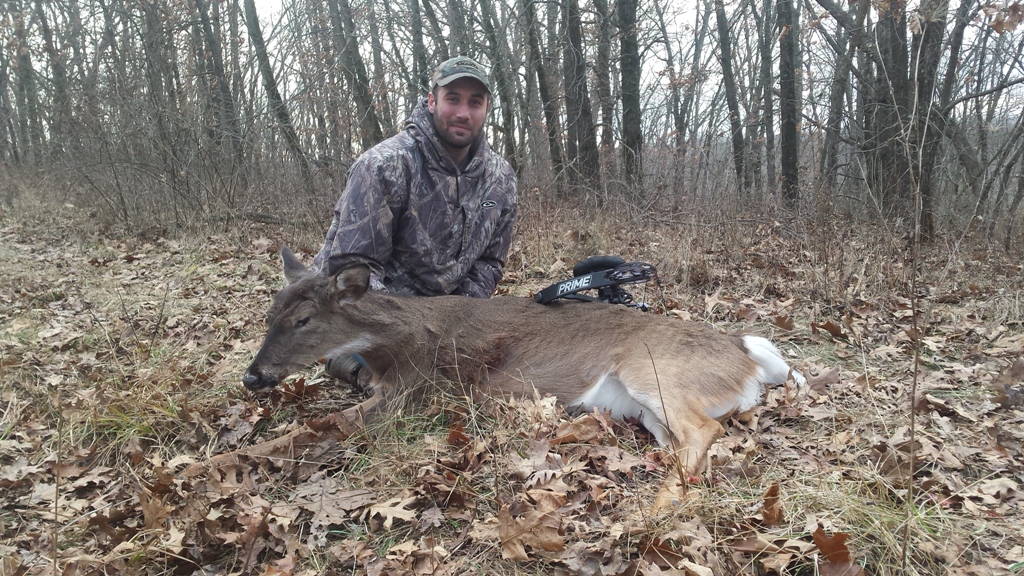
This doe was traveling from a food source to a bedding area during a late season hunt.
Not every property is laid out like the one I hunt back home but the same basic principles lead to successful hunting tactics. We use these exact hunting strategies at The Proving Grounds. Understanding how deer move on a property in relation to food sources, cover, and water is the biggest key to hunting the entire season – especially during the late season.
During the late season, quality cover and food become extremely important. Deer need energy to get through the lean periods of winter. Often by the late season, deer have been pressured by hunters and hungry predators and are seeking the best cover available. That is when finding the travel corridors become critical to late season success. Deer are often on their feet during daylight hours traveling to and from these two sources.
If you still have a few days or weeks left of season, you may consider honing in on how deer are moving from cover and food. If your season has already ended, it is a great time to get into the woods and begin scouting for next year. Deer sign is often easy to read this time of the year and can pay off in years to come.
Enjoying Creation,
Daniel
Trapping Tips & Techniques
Last year’s hides are back from the tannery! Every year we get to reap the fruits of our labor on the trap line with furs that we use as gifts or make into garments. Last year Mrs. Tracy had a beautiful blanket made from raccoon and coyote fur.
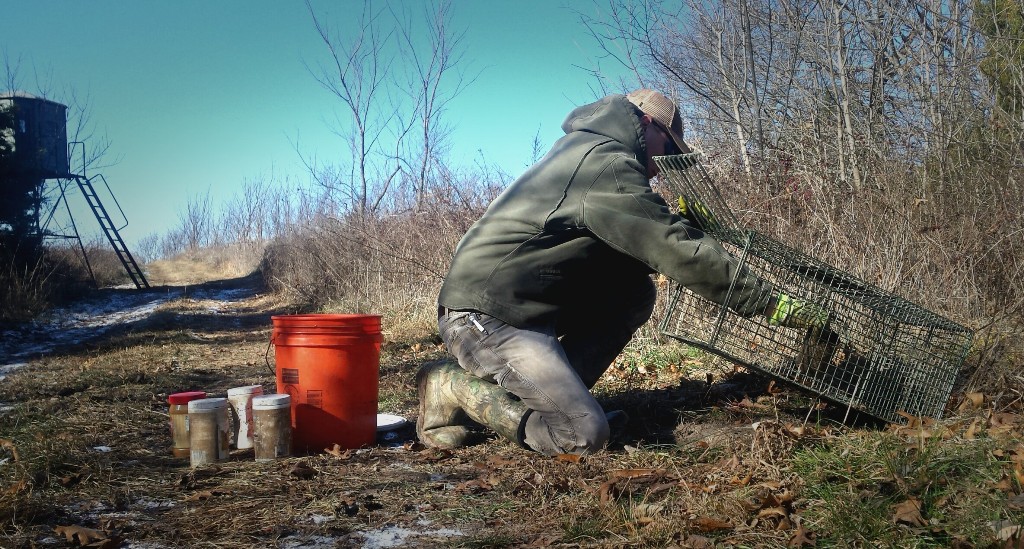
Duke Cage traps are easy to set and use.
Over the past few years fur prices have plummeted. Because of rock bottom fur prices, many trappers have decided that trapping is not worth their time and money spent. This has led to increased predator populations. It is now up to land managers to step up and help balance predator numbers.
If you are trapping to help balance predator numbers listen up! Over the years we have found several tricks that can help you become more efficient with your time.
First, we like to set our traps along the interior roads of our property. We don’t spend time diving deep into the woods to find a game trail or den tree. Many times predators will use the existing road system for their means of travel. The likelihood of predators cruising by looking for a meal is increased if traps are set at intersections of roads or creek crossings. Having traps in these locations makes it very easy to check traps while simply driving through the property and limits disturbance.
We use Duke Cage traps because they are very easy to open and close. We recently had a nasty cold spell. Often, critters will den up during extremely cold nights and then come out during the first warm night. With Duke Cage traps, we can quickly close all our traps when it’s forecasted to be extremely cold or if rain is headed our way. When it’s dry and warm we can reopen the traps quickly and easily.
Placing the bait in a tin can helps protect the bait from the weather. This saves time rebaiting when we do close and reopen traps. Often times we use cheap cat food as the main portion of our bait. Cat food smells meaty and appeals to hungry predators but absorbs moisture. By placing our bait (cat food) in the tin can, we are able to close traps for a few days then reopen, and often do not need to rebait.
Even though fur prices are low, there are ways to save money on the trap line so it is more affordable and you can reap the benefits. You may not get rich this year by selling hides but trapping will provide furs to enjoy, increase fawns and turkey poults, and allow you to spend time in creation.
Enjoying Creation,
Daniel
Why Bucks Shed Their Antlers
If you are planning to spend the next few weeks in a stand trying to fill your remaining tags, listen up. We’ve already received several reports of shed bucks across the whitetails’ range. At The Proving Grounds, our Reconyx cameras recently captured a young buck that had already shed one of his antlers. The time stamp read December 11th!
What causes bucks to shed? The answer has much to do with decreasing testosterone levels.
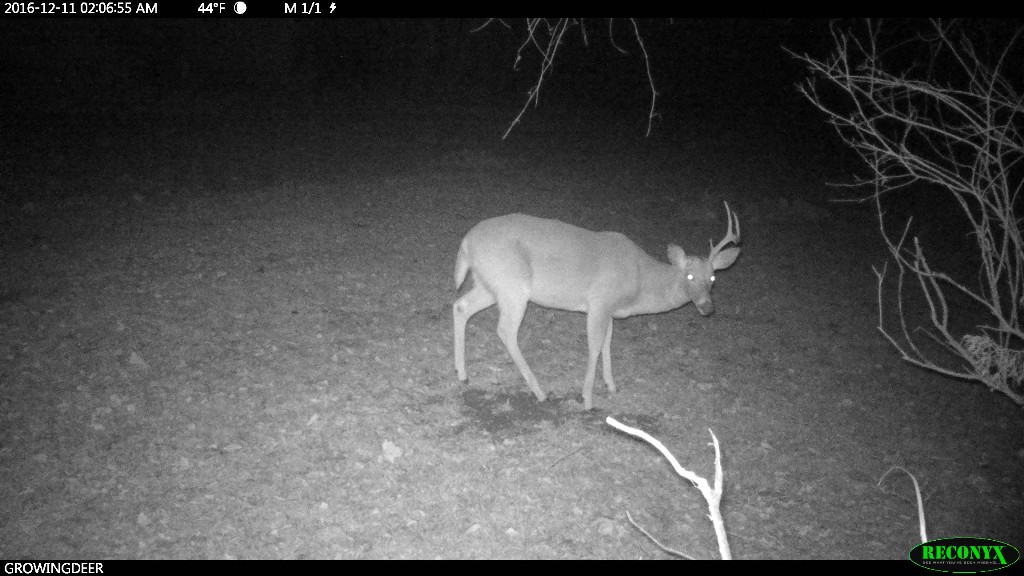
It may seem early, but there are many factors influencing when antlers will fall.
The photoperiod, or the hours of sunlight in a day, greatly influences testosterone levels. As the daylight hours begin to increase during the winter months, a buck’s testosterone level begins to decrease. The opposite occurs in the summer. As daylight hours grow shorter in late summer, testosterone levels increase and prompt velvet bucks’ antlers to harden then shed.
Testosterone levels are also influenced by stress. Stress can come in many forms. Deer can become stressed if they’re pressured by predators such as coyotes or hunters. Stress can also come hand in hand with an injury. If injured, a buck may experience extreme physical stress as the body begins focusing on healing and survival. Nutrition, especially during cold winter days, can also play a huge role in whether a buck becomes overly stressed. Many times healthier bucks retain higher testosterone levels and will hold their antlers longer.
It may sound “early” to hear that bucks are already shedding. However, daylight hours have just begun to increase again. Across much of the whitetails’ range the rut is over. Bucks have recently fought and traveled many miles, increasing the likelihood of being injured. Colder temperatures have swept across most of the United States and quality food sources may be hard to find. Testosterone levels will continue to fall and so will the antlers.
If you are headed to the woods during the next few weeks, remember that some bucks in your area may have already shed their antlers. It can be frustrating if you are trying to fill the freezer and mistake a shed buck for a doe. As you look through your trail cameras pictures be looking for shed bucks on your property. Knowing if bucks have begun shedding in your area can help.
I hope everyone has a blessed Christmas and a great late season hunt!
Enjoying Creation,
Daniel
Deer Hunting: Your Best Management Tool
Mid December can be a rough stretch for many hunters. Throughout much of the whitetails’ range the peak of rut has ended and things seem slow in the woods. This can be a frustrating time for those who haven’t tagged a buck. During this time of the year I often think about the saying “don’t pass a buck on the first day that you’d shoot the last day”.
Recently, I went through our Reconyx images and realized that we have a greater number of three year old bucks than mature bucks. With Missouri’s upcoming muzzleloader season and several weeks remaining in archery season, it is very likely that we will have multiple encounters with three year old bucks. As season draws to an end with an unfilled buck tag left, letting these great looking deer walk can be hard.
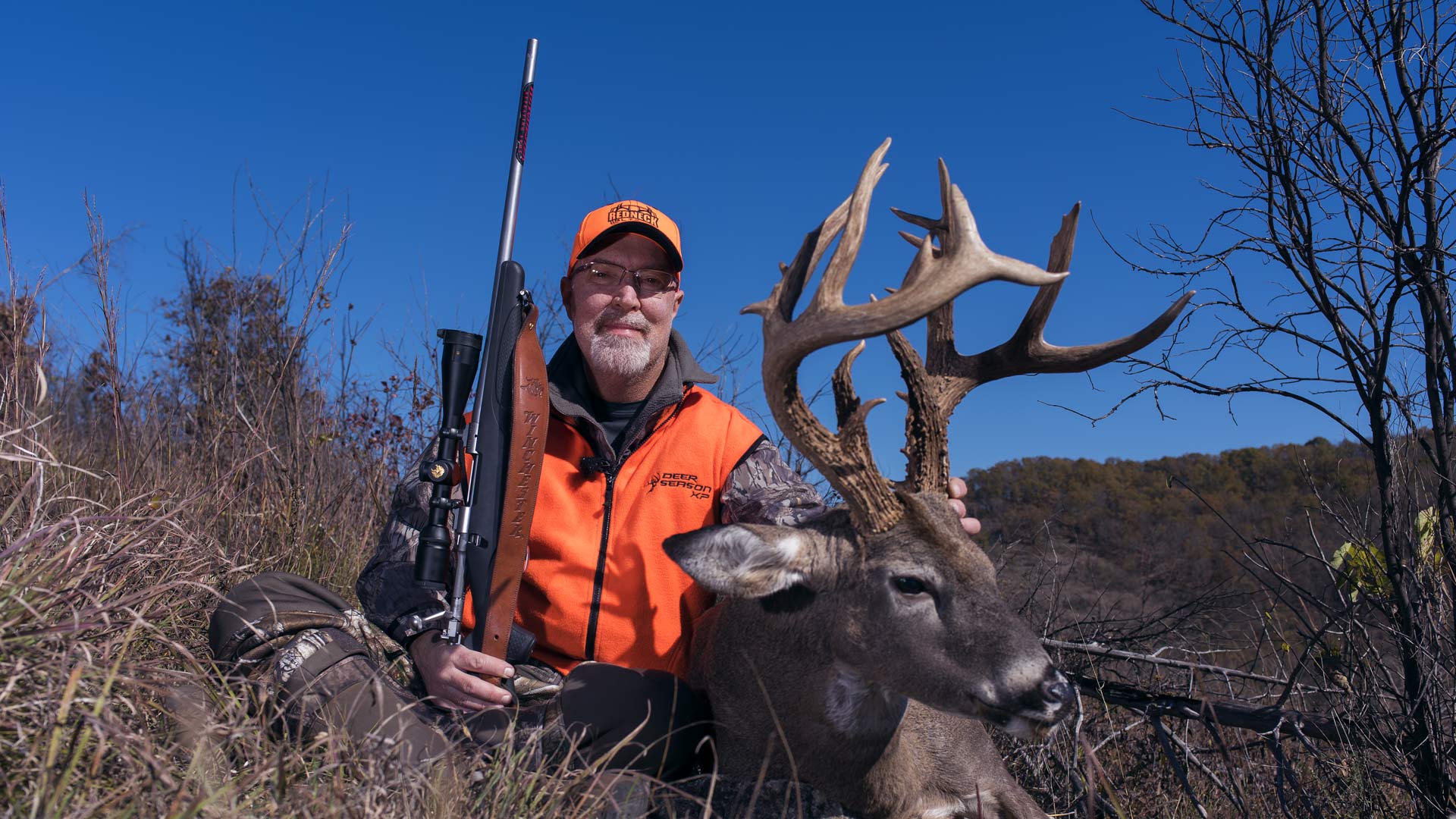
Passing this deer at three years old allowed him to express more potential.
At The Proving Grounds, part of our management objective is to harvest bucks four years of age or older. At the beginning of each season we develop a “hit list” of all the four year or older bucks captured on trail cameras. The list of mature bucks will be the only bucks we will harvest if given the opportunity. However, it never fails, throughout the season a three year old buck will walk by. This can be very tempting, especially toward the end of season, but we keep our finger off the trigger. We hold out to the very end, even if it means we are left with an unfilled tag.
Several seasons ago, we passed two incredible three year old bucks. It was difficult not to shoot but we stuck to our goal. This year we were blessed to harvest both previously passed bucks. Once we laid our hands on them, it was worth the wait. One of the bucks, Gumby, had developed two drop tines, one measuring eight inches! The other buck, Handy, had 19 points and grossed 173”! Even though there were two unfilled tags several years ago, it was worth it in the end.
If you’re down this season because you haven’t tagged a buck, keep whatever goals you had at the beginning of the season. If you wouldn’t have shot a deer on the first day, think twice about shooting it the last day just to fill a tag. If a young buck has made it this long through season, there is a chance he may still survive. Letting young bucks walk can lead to great future hunts.
Enjoying Creation,
Daniel
Keys to Hunting Success in the Post Rut
For most deer hunters, the anticipation for the rut builds for many months. However, the season always seems to drift away much faster than it arrives. If you were unable to fill a tag by the end of the rut, it can be easy to get discouraged. Don’t give up yet! It only takes a few pieces to unlock the key to post rut success.
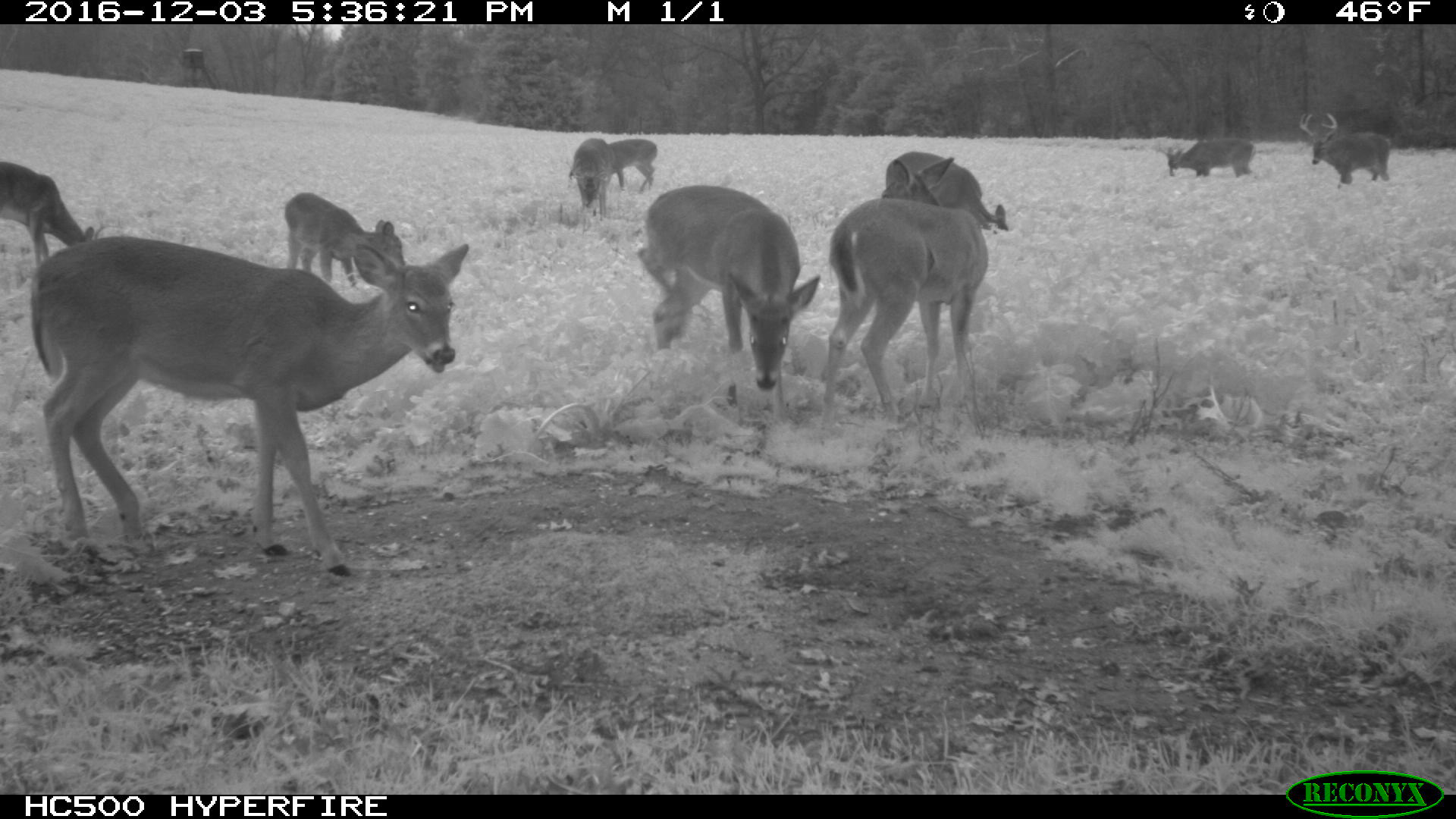
Hunting food sources can help tag a late season deer.
A whitetail’s body goes through a lot of stress during the rut. It’s critical that they refuel and replenish during the next few months to survive through the stress period of late winter. As slaves to their stomachs, this can be the weak link in their travel patterns and can make them fairly easy to pattern.
Hunting areas that are near, or on food sources, can give you the advantage you need to seal the deal. Some of the most attractive food sources this time of year are grains, like soybeans and corn, or brassicas, like radishes and turnips. Deer tend to feed more during daylight hours on days when the temperature is lower than average so bundle up.
Did you take the time and effort earlier in the season to plant food plots? Have you scouted to find the best food source in the area? Then your hard work is about to pay off.
Time your hunts with cold temperatures, a solid food source, and a favorable wind. This is the absolute best ticket to filling a tag in the post rut. Whether you’ve already filled a tag or not, don’t let the post rut blues take you out of the game. With the right conditions, and maybe another layer or two, you can still experience some of the best hunting the season has to offer.
Enjoy Creation,
Clay
Trapping Now, Turkeys Later
Let’s talk turkey! No, I’m not talking about Thanksgiving leftovers. Now is an important time of the year to begin thinking about turkeys. Even though deer season is still in full swing at The Proving Grounds, we are spending fewer mornings climbing into Summits and more time on the trap line. Why? Because we love chasing turkeys in the spring!
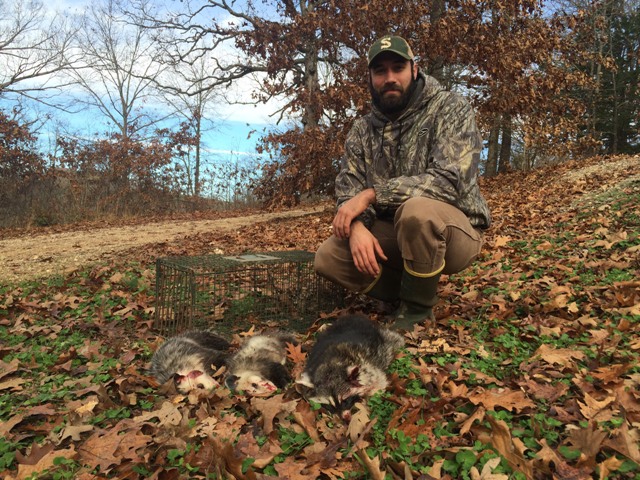
Another great start to future turkey hunting!
Each year the Missouri Department of Conservation takes a turkey survey. Hunters and wildlife managers record the number of turkeys and poults seen in the field. The survey helps provide an estimate of how many poults hatched the previous spring and Missouri’s turkey population. This fall, the Missouri Department of Conservation shared that poult numbers were very low across the state. However, based on our observations, The Proving Grounds has great poult numbers.
Why are there a higher number of poults at The Proving Grounds compared to most of the state? We trap predators, hard!
Each trapping season, we remove 50+ predators. That means fewer predators sniffing around looking for turkey eggs next spring. Trapping season began a few days ago and we are not wasting time. The Duke Traps are on the ground. We have already removed several raccoons and opossums – both are notorious turkey nest predators. We will start targeting coyotes soon.
If you enjoy long beards in the spring and wish for turkey and deer numbers to increase at your Proving Grounds, consider trapping. You will enjoy the results. We have!
Stay tuned for more trapping tips and techniques throughout the winter.
From the trap line,
Daniel
Prepare For A Second Surge
Keep those seat belts fastened! The post-rut in many portions of the whitetail’s range is just around the corner. Oftentimes this phase of the rut is just as exciting as the first. The post-rut is the period of time after the primary lock down phase where bucks are back on their feet seeking the last remaining receptive does. With fewer does receptive during this time, bucks generally travel more. The keyword here is “travel!”
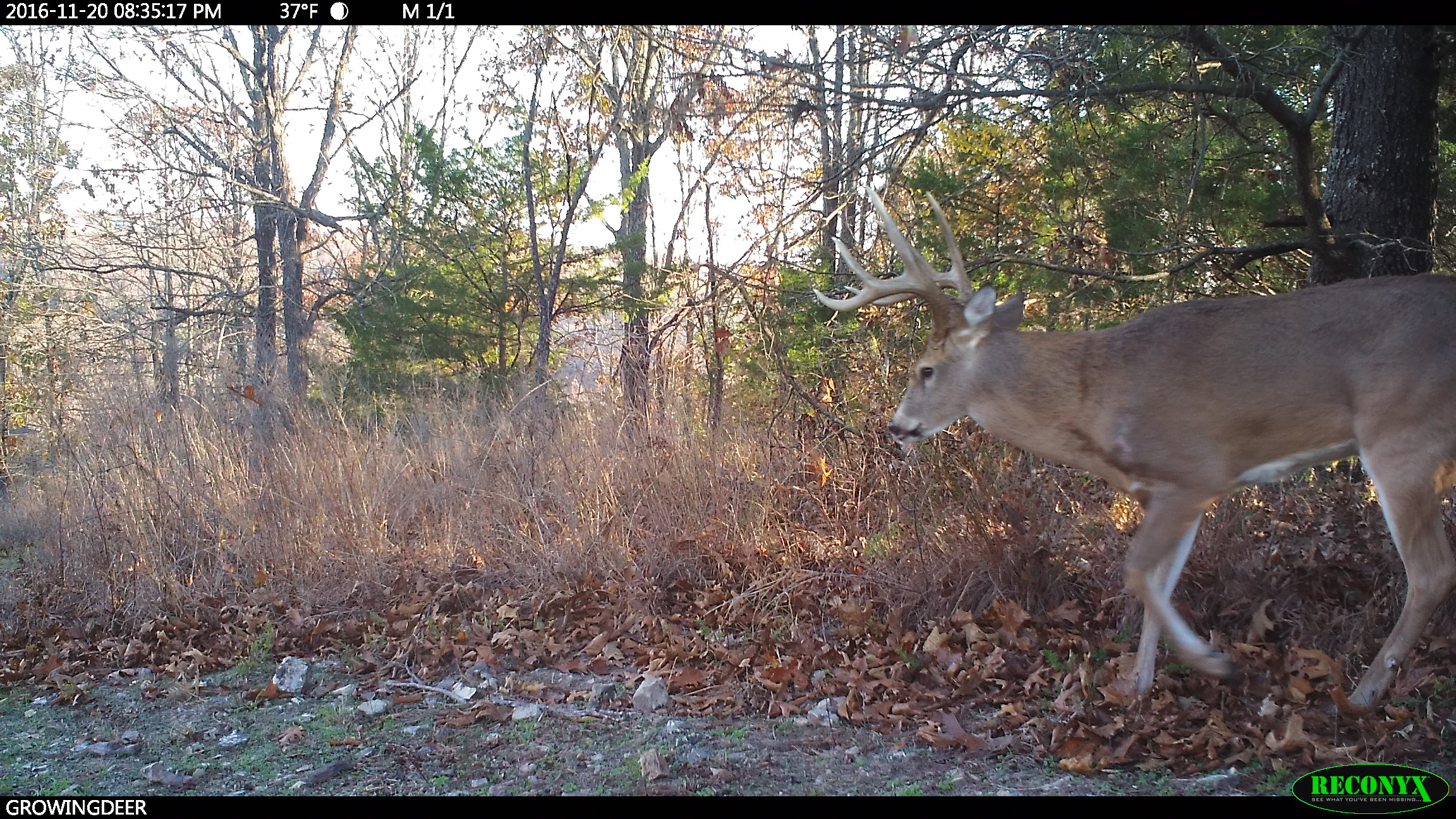
Southpaw is in pursuit. Notice his proximity to thick cover!
Over many years here at The Proving Grounds we have documented the average conception date to be November 14th -16th. This means most of the does are bred during this period, but not all does will come into estrous at this point. Some will come into estrous after this time frame. The number of does will be far less than the peak rut, as a result, there will be increased competition for them. The smaller percentage of receptive does requires bucks to travel further and longer. Traveling this much often results in more daylight movement.
To capitalize on does still being receptive and bucks on their feet, position yourself along a travel corridor between bedding areas. After nearly a month of being pushed and pestered, does often seek thick cover for refuge. Bucks will be working edges with the wind in their favor to find them. This is when travel corridors become great places to intercept mature bucks.
Don’t give up on the rut yet! There is still great action to experience in the deer woods. Stay persistent and hunt smart!
Chasing whitetails together,
Matt Dye
How Mature Bucks Use The Wind
It’s November and that means the rut is right around the corner! Some hunters have already experienced great hunting during the pre-rut. If you haven’t punched your tag yet because of the heat or bucks not chasing, get ready. This time of year anything can happen.
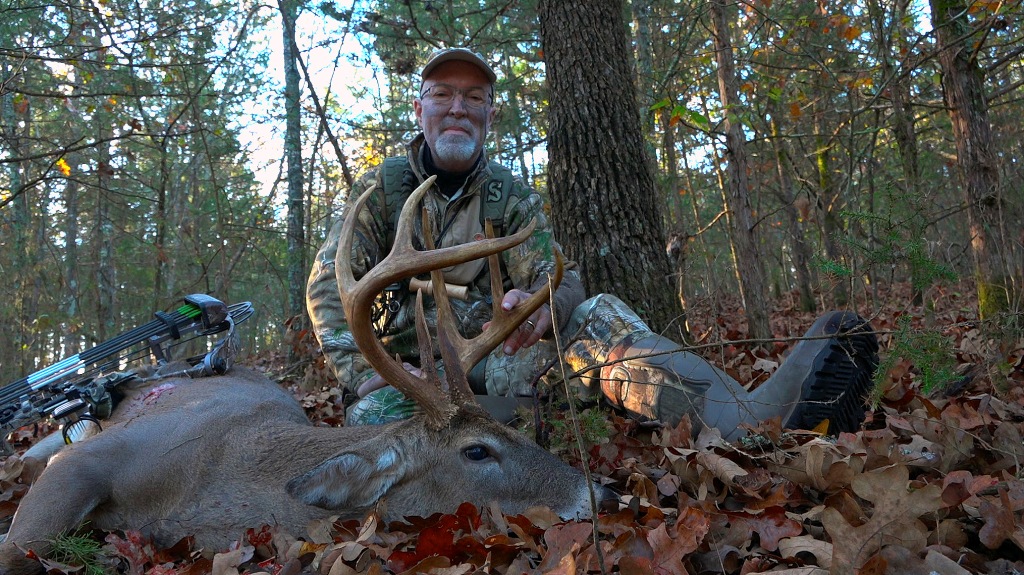
Considering the wind is key to killing a mature buck.
Over the past week, I have watched two mature bucks be killed with a Prime bow. As I reflect on both hunts, I realize how different they were, even over a period of one week. One hunt was a single mature buck working through a small hidey hole food plot. The other was a buck trailing a soon to be receptive doe. The two hunts were different in many ways but there was a similar feature. Both mature bucks were moving with the wind in their favor.
During the first hunt, the mature buck was cutting across the wind. Upwind of the buck was a small thicket. (Receptive does often seek security in thick cover.) This buck was obviously using the wind to scent check the nearby thicket for a receptive doe and to warn him of danger up ahead.
The second hunt was one we all fantasize about! One doe, young bucks running all around, and the mature buck chasing them off with the occasional grunt and snort wheeze. As this all unfolded, I watched the doe and the mature buck use the wind. The mature buck and the young bucks were always downwind of the doe, waiting for the moment to move in. Even the doe cut across the wind aware of what was ahead; knowing any moment a buck was going to be chasing her forward.
These hunts are a reminder of how deer use the wind, especially mature bucks as they seek receptive does during the rut. If you want to be successful over the next few weeks, consider where the deer will be traveling and where the wind will be carrying scent.
The GrowingDeer Team hopes you have a blessed rut. Be safe and enjoy your time in the woods.
Enjoying Creation,
Daniel





















